Abstract
The aim of the study is to develop innovative intelligent technology and information systems of distance education for people with impaired vision (PIV). To solve this problem a comprehensive approach has been proposed, which consists in the aggregate of the application of artificial intelligence methods and statistical analysis. Creating an accessible learning environment, identifying the intellectual, physiological, psychophysiological characteristics of perception and information awareness by this category of people is based on cognitive approach. On the basis of fuzzy logic the individually-oriented learning path of PIV is con- structed with the aim of obtaining high-quality engineering education with modern equipment in the joint use laboratories.
1 Introduction
A distinctive feature of the modern world has become a global development of information technologies and its use in education is especially effective. Today distance learning (DL) is one of the most rapidly developing areas in the world educational environment that provides equal opportunities to all people regardless of social status and can react flexibly to the needs of leaners [1]. Especially the creation DL for people with disabilities is important. Since many people in the world [2, 3] have problems with vision (Figure 1) and organization of the e-learning process involves spending a lot of time in front of a computer, which negatively affects the visual apparatus, it is of great importance to develop distance learning systems for people with impaired vision (PIV). Currently great attention is paid to training of PIV and their social adaptation.
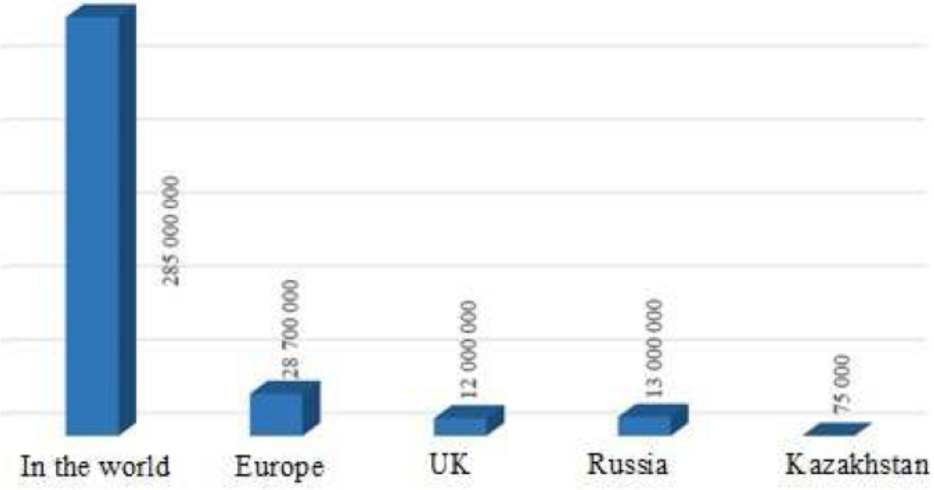
Number of people with visual impairment in the world
Currently with the development of distance learning systems the various methods of artificial intelligence [4] are widely used, such as neural networks (NN), fuzzy logic (FL), neural-fuzzy networks (NFN), genetic algo- rithms (GA), artificial immune systems [5] etc. A number of foreign scientists’ works dedicated to the development of intelligent information systems of distance learning. It may be noted that most interesting works of the following scientists: Tollefsen Morten, Magne Lunde (Norway), A. Sangra (Spain), Kim N. (South Korea), V. L. Uskov (USA), etc. The main feature of the existing distance learning systems based on artificial intelligence approaches is the processing of multidimensional inaccurate data and identifying hidden knowledge [6].
When creating intelligent systems of distance learning good results can be achieved by an integrated approach and combining different artificial intelligence techniques, statistical methods [7], ontological [8] and cognitive approaches.
The application of ontological approach to create intelligent systems of distance learning has its own specific features. Ontology models allow to create an effective intelligent information systems and implement the interaction between complex structured and formalized data. The aim of the study is the development of intelligent technology and information system DL for people with impaired vision with a holistic approach based on intelligent and statistical techniques as well as cognitive and ontological approaches to individually-oriented learning path based on the perception of information by people with impaired vision and a quality engineering education using modern equipment.
Combined model OWL has been developed, which includes an ontological model of a learner, learning and joint use laboratory [8].
Work [7] describes more details the selection of informative features by using the principal components method based on the statistical software package SPSS. On the basis of the obtaining results, the appropriate learning path is selected and mode of supply of educational material taking into account the characteristics of each PIV with the aim of improving the quality and effectiveness of learning, identifying the intellectual, physiological, psychophysiological characteristics of perception and awareness of information this people category on the basis of cognitive approach and the creation of an accessible learning environment with connectivity to a joint use laboratory.
We introduce the following definition: any laboratories with complete infrastructure (advanced equipment, technical and software) for the implementation of distance learning and obtaining high-quality engineering education by PIV are considered as joint use laboratories.
As an example of DL PIV at the National scientific laboratory of joint use of information and space technologies of the KazNITU named after K. I. Satpayev the training material on discipline “Information systems design” was presented for DL PIV.
It is necessary to construct a model of learning adapted to the learners’ model based on fuzzy logic to create a suitable learning path. This approach contributes to the definition of the learner’s class as vision and current knowledge of PIV. The creation of such a system aimed at adaptation of PIV in society is one of the important problems of modern education.
It is proposed the following structure of the article: the second section discusses literature review of DL systems based on modern approaches of artificial intelligence.
The third Section describes methods of solving the task. The fourth Section presents the results of the study. The fifth Section is devoted to the discussion of the findings. The sixth Section contains a conclusion and a list of used literature.
2 Literature Review
In the fast-paced modern society, where the amount of information exceeds the capabilities of human perception, there is a need to develop and apply of new innovative and effective approaches of DL. The increasing amount of information requires the development of intellectual (cognitive) abilities of the learner. The term “cognitive” appeared in 1960 (from the Latin word cognition-knowledge, cognition) means “informative”, relevance to cognition” [9]. In the cognitive approach, special attention is paid to traditional cognitive processes such as perception, attention, memory, imagination and thinking. All these processes are considered as components of the overall process of information exchange between man and environment. Characteristic of this approach is the use of various cognitive techniques and trainings [10] in the organization of training activities for the development of cognitive abilities in the learners. Formation and sustainable development of the cognitive skills of PIV throughout life is an important element of the educational process. The core of the cognitive approach is to solve such tasks as: awareness of knowledge, skills, structuring and use of knowledge by learners in the learning process [11]. This approach attempts [12] to learner-centered education, individualized methods, techniques and learning technologies that increase the quality of education.
Cognitive approaches are mainly used in intelligent systems based on knowledge [13]. In such systems artificial intelligence methods are widely used to improve the efficiency of the DL systems. The current approach to the development process of DL intelligent systems involves the introduction [14] the platform of fuzzy logic and artificial neural networks. Work [15] discusses the application of the FL platform for the design and construction of intelligent subsystem for use in DL. The organization of the process of DL with application of AI technologies gives the opportunity to dynamically adjust the learning material for each learner. In the study [16] a fuzzy hybrid system has been established. The uniqueness of the system is application of neural networks and fuzzy logic. The forecasting algorithm of the training course advancing with the help of FL has been developed. Fuzzy logic is used during the classification of leaners according to their level of knowledge both quantitatively and qualitatively. Fuzzy logic apparatus allows for a small amount of information to make a recommendation to the teacher about the directions of improvement of training course. A neural network is used for teaching students and monitoring their learning. A convenient interface has been created for a teacher and a learner.
One of the main methods of visual perception developing is a psychophysiological method [17], which activates the thought processes of PIV. Psycho physiological method includes a specially prepared visual activation that increases functional ability and improves the basic functions of vision. This method is designed to correct for violation of the perception of the basic object properties (contrast, shape, size, color) in different conditions. It is performed using special psychophysiological stimulant, which modifies the characteristics of the image and converts the activation conditions (adaptation, fixation frequency).
Psychophysiological direction includes a method of modifying neural networks, affecting the property of brain plasticity [18], which is used to activate and enhance the functional activity of view, the development of visual function.
The novelty of the article is denoted by the integrated approach at the development OF PIV DL based on combined use of intellectual and statistical methods for the processing of multi-dimensional data, and on psychophysiological peculiarities of perception and awareness of learning information by people with impaired vision on the basis of cognitive and ontological approaches.
3 Methods
Different methods are applied in [19] under different loads to study the physiological characteristics of the visual apparatus of the visually impaired. Visually impaired or blind learner as other is in progress in accordance with their capabilities. The development of PIV differs from the learner’s development with normal vision. They have arrested development. It is need to create favorable conditions for the perception of information taking into account these characteristics. Improper organization of learning activities affects the cognitive process of PIV. This leads to a rejection of the emotional and intellectual development and reduces the effectiveness of the training.
Taken through the eye the light rays focus on the retina. The perception by the brain of visual information in a general form is as follows [20]: the brain processes the received information through the eye. Then the visual pathway of the brain is connected and computing processes are performed. External impacts are registered. Outer protective layer of the eye (cornea) gives clarity and focuses an image. Then information goes into the inner surface of the eye (retina) and excites the light-sensitive cells. Retina generates nerve impulses that are moved to the brain to interpret vision. Here are some of them responsible for the contrast, and the second part-for the transmission of color. Each cell in the likeness of CPU processes information and further transmits it in the form of electrical impulse. The signal is transmitted to the area of the cerebral cortex through the optic nerve through the optic canal. When receiving information other areas of the cerebral cortex are connected.
Learners on the nature of diseases and the extent of violations of basic visual functions perceive and recognize the information received in different ways. Different degrees of visual impairment affect the psychophysiological characteristics of PIV in learning. The following diseases are considered: myopia, hyperopia and astigmatism. In case of myopia [21] the person badly distinguishes objects located at a far distance. The image is focused not on a specific area of the retina, but it is placed in the plane in front of it and as the result distant objects appear blurred (Figure 2a). With hyperopia the image focuses not on a particular area but it is in the plane behind the retina and the image is poorly perceived in close proximity. (Figure 2b).

The structure of the eye in cases of myopia and hyperopia
An ophthalmological disease astigmatism is one of the most common causes of low vision [21]. In this defect of vision form of the lens, cornea or eye is disturbed, and the capacity to clear vision is lost. Often the astigmatism is combined with myopia or hyperopia.
Questionnaire based on Amthauera R. and G. Eysenck tests is used to implement the cognitive approach. Test of intelligence by R. Amthauer and a test of verbal intelligence by G. Eysenck [22] are used to assess the intellectual abilities, mental health and fatigue. Intelligence structure test of Amthauer was developed by the German psychologist Rudolf Amthauera in 1953 in Germany. This test helps to determine the intelligence quotient [23]. In studies of Amthauera much attention is paid to the similarity of intellect and professional activity of the subject. The Eysenck test [22] was developed by the English psychologist Hans Eysenck. It consists of a series of tests and is available in eight different variants. The technique of this test is to identify original thinking and in assessment of intellectual abilities in people aged 18 to 50 years old with at least secondary-level education. Verbal, numerical and graphical materials are applied in preparation of the test. This approach helps the study of the intellectual and personal characteristics of students: the intelligence structure, general and special levels of academic achievement, rate of learning, performance, endurance, willpower, result achievement motivation etc. The Duochrome test is proposed for the independent verification of the health status on defect of eyesight that contributes to the determination of myopia, hyperopia or emmetropia (norm) of the eye. The table is divided into two parts: the left side is red, right side is green and the letters on the background are black. To check the view on this table a person has to be in a light room and cover one eye with hand (a piece of paper) and read letters on both sides of the table. And this procedure should be performed with the second eye. Test results: if the subject sees the letters on both sides equally, then he has emmetropia (normal vision). If the letters are clearly visible on a red background, it is a high probability that he has myopia; if green, then the subject has hyperopia.
Fuzzy logic is implemented in the MATLAB (Matrix Laboratory). MATLAB [24] was developed by Cleve Moler who was the Dean of the faculty of computer science at the University of New Mexico as a programming language in the late 1970-ies, which is a software package for solving problems of technical computing. One of the main features of the MATLAB language is the wide use of this package for multidimensional data analysis, to develop algorithms and create models. The MATLAB language includes mathematical functions for engineering and scientific operations. It is also handy when compiling fuzzy rules. The rules of fuzzy products are formed in the Rule Editor of MATLAB, which produces all the necessary procedures in accordance with the selected algorithm (Mamdani) of fuzzy inference. Then the rules of fuzzy logic are formed. The main advantages of the use of Mamdani algorithm include the following [25]:
works on the principle of “black box” (he input are the quantitative values and on the output are numeric values). In the intermediate stage the fuzzy logic and fuzzy set theory are used);
manages numeric data using the flexible possibilities offered by the fuzzy systems
increases accuracy when training on the original data;
based on fuzzy inference and avoids a lot of computation.
4 Results
In the course of solving the tasks the high-level algorithm of innovative intelligent technology of DL PIV has been proposed.
Algorithm 1 of the innovative technologies of DL PIV
Registration of PIV in innovative, intelligent technology of DL. The choice of the subject and duration of training.
Building a model of PIV, taking into account characteristics of view, based on questionnaires and test using cognitive approach.
Creating a database and knowledge base.
Organization of the special environment information perception of PIV for various pathologies of vision: myopia, hypermetropia and astigmatism.
Accepting requests from PIV and data transfer to the interpreter of server-side scripting.
Building a learning model adapted to the student model based on fuzzy logic.
Class teaching is selected on the results of questionnaires and knowledge level of PIV: elementary level, intermediate level, advanced level.
Construction of individual-based learning trajectory and organization of access of PIV in the joint use laboratories for the implementation of practical, laboratory and individual work with modern equipment.
Structural diagram (Figure 3) of application of cognitive approach in creation of innovative intelligent technology of DL PIV.
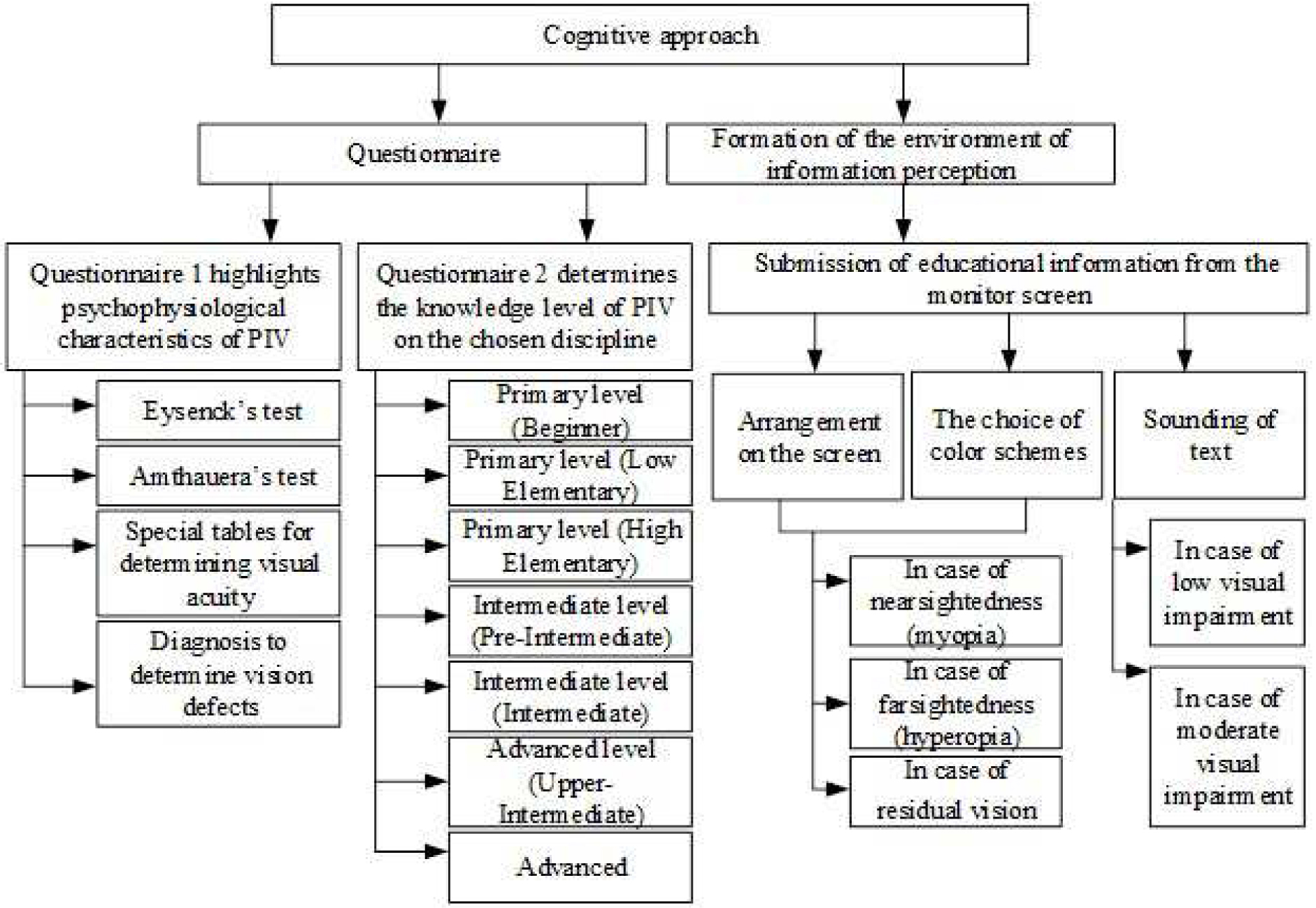
Structural diagram of application of cognitive approach in creation of innovative intelligent technology of DL PIV
Cognitive approach on the basis of the survey is used to identify the psychophysiological features of PIV to collect features that characterize PIV and when submitting educational information from the monitor screen, taking account of the defects of vision and building a learner’s model. An intelligent method based on fuzzy logic is used to build learning model adapted to the learning model of PIV. The survey process consists of two stages: questionnaire 1 and questionnaire 2. Questionnaire 1 highlights psychophysiological characteristics of PIV by means of tests Eysenck and Amthauera [23], special tables for determining visual acuity and diagnosis to determine vision defects. Questionnaires of students helps to identify the intellectual, physiological, and psychophysiological characteristics of perception and awareness of information of PIV and contributes to the construction of a learner’s model.
Survey questions of the developed system consist of the following characteristics: age, education, hobbies, ability to work in a team, emotional stability, health status by defect of vision, visual acuity, logical thinking, cognitive activity, psychological characteristics, strongwilled potential, physiological potential, motivational potential, read techniques, knowledge control and perception of information. The results of the survey reveal emotional stability, intellectual potential, assimilation of information, taking into account peculiarities of vision and motivation in the student. Questionnaire 2 determines the knowledge level of PIV on the chosen discipline and contributes to the learning class selection of PIV, which is divided into primary level (Beginner, low Elementary, High Elementary), intermediate level (PreIntermediate, Intermediate) and advanced level (UpperIntermediate, Advanced).
Submission of educational information from the monitor screen by using the text-to-speech (in case of low and moderate visual impairment), the information arrangement on the screen and the choice of color schemes. Various information arrangement on the screen and choice of specific color schemes are considered in case of myopia and hyperopia.
It is especially important to consider the information perception of PIV when creating such systems. One way is the correct submission and arrangement of information on the screen [26]. In this system, attention is paid to the arrangement on the monitor depending on the psychophysiological characteristics of information awareness and view characteristics. According to the experiment results the possible preferred information arrangement on the screen has been identified in various visual defects (Table 1) and there is a choice of colour schemes for a better perception and understanding information.
Preferable information location on the screen in various visual defects
| Scope | Details |
|---|---|
| in case of nearsightedness (myopia) | information arranged at the left side of the screen is well perceived pale yellow or pale green screen background black font |
| in case of farsightedness (hyperopia) | information arranged in the lower right corner of the screen is well perceived bright yellow or bright orange screen background black font |
| in case of residual vision | color scheme of “white-black” (white text and black background) is provided to obtain a clear contrast sound connection |
It is need to know the effect of color on information perception of PIV with different visual impairments when selecting colors for the submission of educational material. Color affects the physiological systems of the person, increasing or decreasing the ability to educational activity. It is necessary to consider the psychological effect of color on the human body depending on the wavelength.
An important aspect in creating PIV DL is a study of the information arrangement on the screen in cases of various visual impairments. The preferable arrangement of important educational information in nearsightedness (myopia) is the left side of the monitor on pale-yellow or pale-green background (Figure 4).
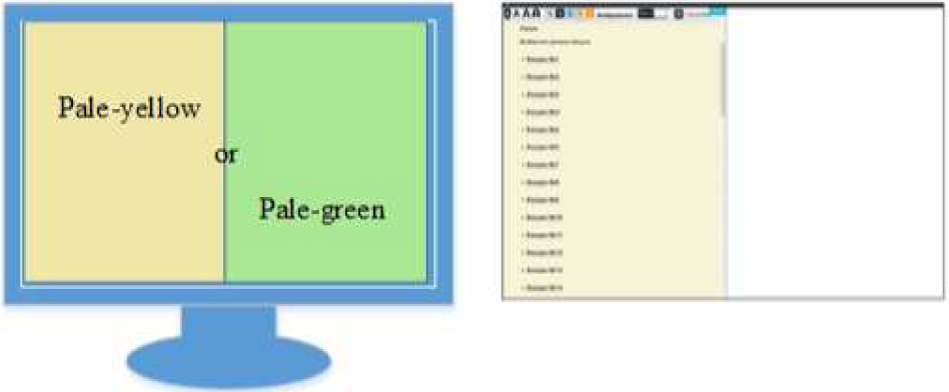
The preferable color-scheme and arrangement of important information on the screen in myopia
In case of hypermetropia the best arrangement of important educational information is the right part of the computer screen on a bright yellow or bright orange background (Figure 5).
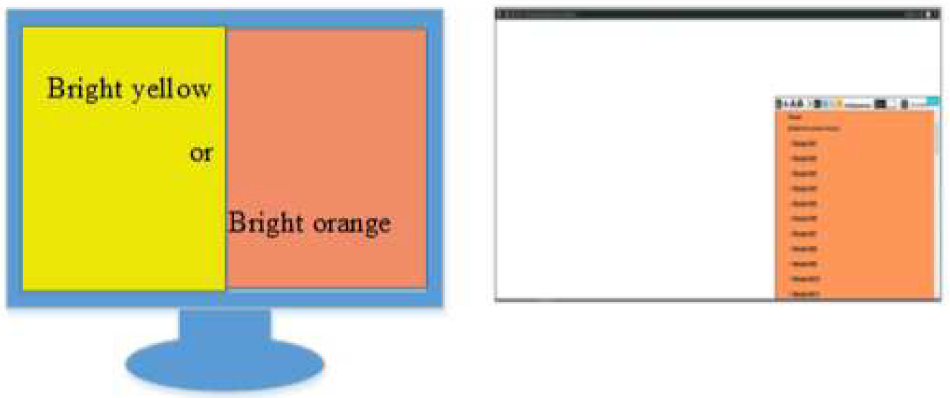
The preferable color-scheme and arrangement of important information on the screen in hypermetropia
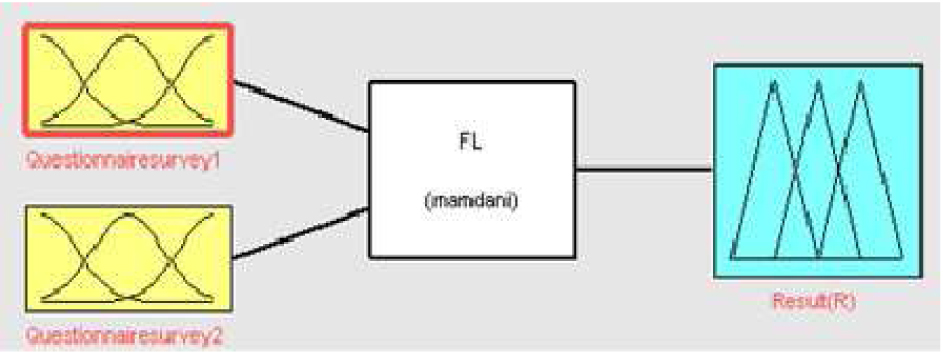
Schematic representation of the fuzzy model in Matlab Fuzzy Logic Toolbox

Description of the first input variable “Questionnaire survey1”
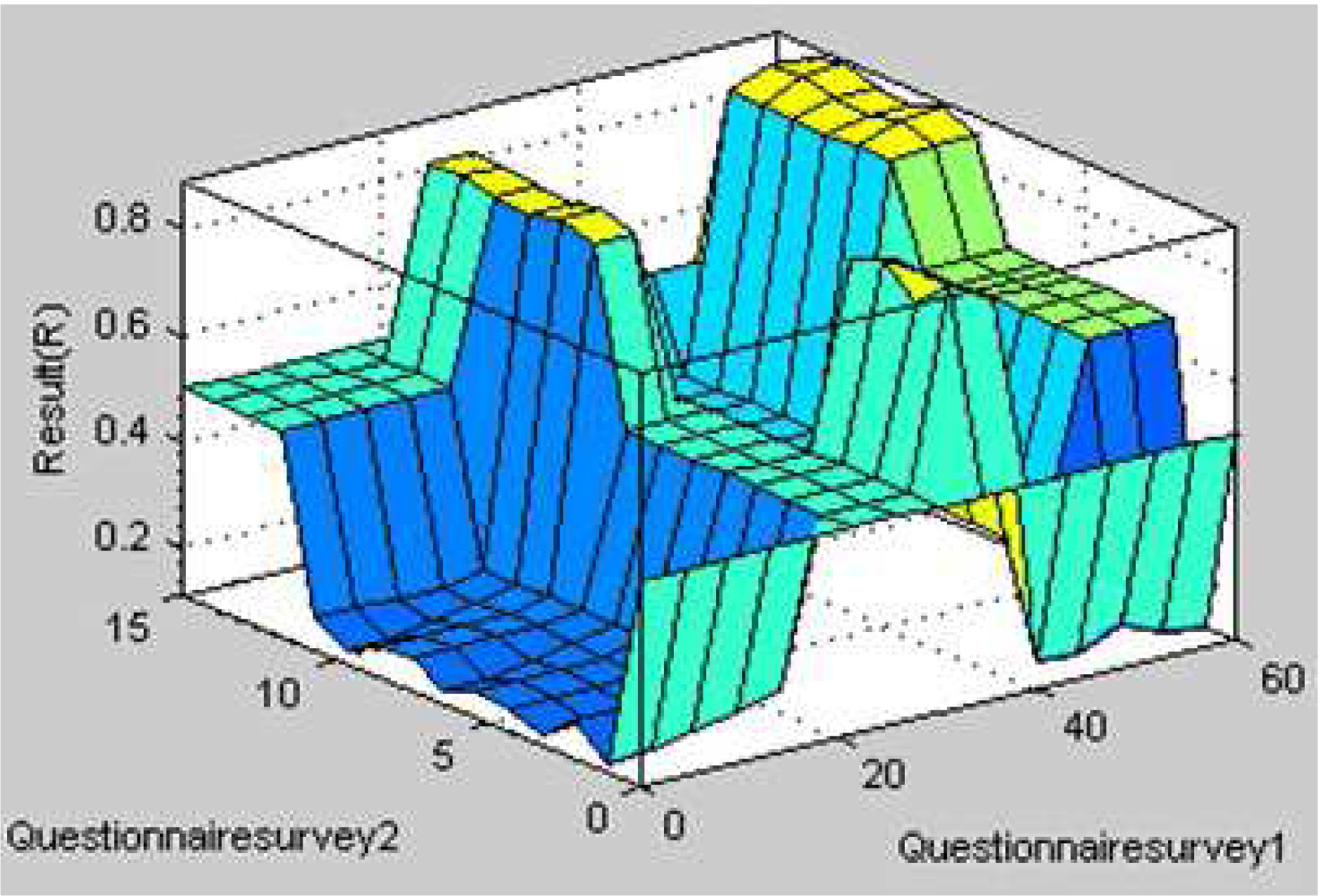
Fuzzy inference surface
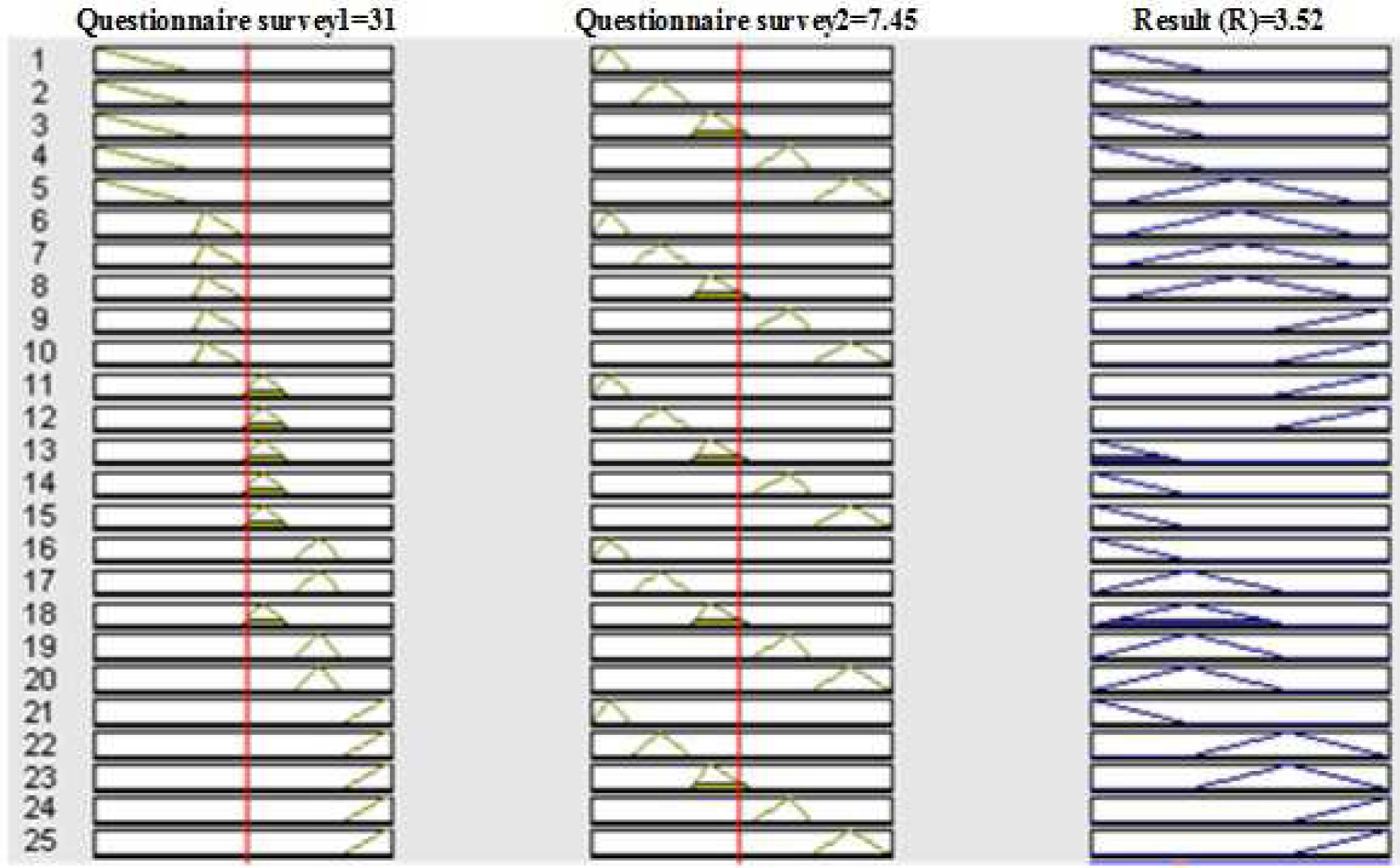
Visualization of the input variables into the output
In order to get a clear contrast for people with residual vision, the “white-to-black” color scheme (white text and black background) is provided.
Speech Synthesis allows students to listen to a vast amount of materials without straining their eyes. It is an obligatory tool for people with partial loss of eyesight, because visual deterioration increases load upon acoustic apparatus.
Then the learning model of adaptation to the student’s model based on fuzzy logic is constructed. Fuzzy logic is used in classifying students according to the results of the questionnaire survey and the level of PIV’s knowledge to select a training class for PIV.
Fuzzy logic apparatus is applied [27] to solve problems in which input data is poorly formalized. The theory of fuzzy systems are based on linguistic approach and allows to create intelligent systems that enhance objectivity in decision-making in applied problems.
Learning model selection algorithm based on fuzzy logic (fuzzy output performance based on Mamdani algorithm [28]) has been worked out:
Algorithm 2 Learning model selection algorithm based on fuzzy logic
Drawing up the rule base of “training class for PIV”.
Fuzzification of “PIV Model” input parameters from questionnaire survey 1 and results of questionnaire 2.
Determination of the conditions’ truth degree on each rule of the fuzzy output system.
Formation of the truth degree finding process of all composed fuzzy production rules.
Finding the membership function to the fuzzy sets of “PIV Model” and “Entry knowledge level of the chosen subject” for each of the output linguistic variables.
Transition from membership function of the output linguistic variable to numerical value.
When determining learning model of PIV, the fuzzy logic based on the results of questionnaires 1 and 2 is applied. Two fuzzy linguistic variables are taken as input parameters of the system (Figure 1): “Questionnaire survey 1” and “Questionnaire survey 2”. “Result (R)” is an output parameter.
A1 = {“bad”, “belowmoderate”, “moderate”, ”abovemoderate”, ”excellent”
is used as the term set of the first linguistic variable of “Questionnaire survey 1” and A2 = {“verylow”, “low”, “average”, “aboveaverage”, “high”} is used for the term set of the second linguistic variable of “Questionnaire survey 2”. Term set of the output linguistic variable “Result (R)” is given in the form R = {“Beginner”, “ElementaryLow”, “ElementaryHigh”, “Pre-Intermediate”, “Intermediate”, “UpperIntermediate”, “Advanced”}.
For the best representation of the term the range of numerical values of each linguistic variable term is defined. In this regard, functions from number of standard membership functions are selected. For example, the first input variable (“Questionnaire survey 1”) is estimated in the interval 0 to 60 (Figure 2).
Rule base of fuzzy productions is essential in fuzzy modeling. Rules of output is formed as follows:
IF A1 is “bad” and A2 is “very low”, THEN R is “Beginner”.
IF A1 is “below moderate” and A2 is “low”, THEN R is “Elementary Low”.
IF A1 is “excellent” and A2 is “high”, THEN R is “Advanced”.
Figure 3 shows the fuzzy inference surface obtained on the basis of the developed training model, adapted to the student model in MATLAB environment.
The process of fuzzy modeling gives an analysis of the of fuzzy inference results for different values of the input variables in order to determine adequacy of the developed fuzzy model. Figure 4 shows a fuzzy model of PIV training level classification to choose an appropriate learning course.
According to the results, it is apparent that the PIV’s training level is Pre-Intermediate. The obtained data is registered into the database. After studying a particular course at the selected level, PIV do a test, re- sults of which are analyzed, i.e. learning outcomes with the use of neurofuzzy network are predicted.
5 Discussions
The research and numerous publications on this subject demonstrate the relevance of the intellectual development of innovative distance learning technology for people with disabilities, including the visually impaired. The developed innovative intellectual technology of distance learning for people with impaired vision has number of advantages. Cognitive approach is applied to identify physiological, intellectual and psychophysiological features of information perception and understanding by PIV. Data submission and position of information on the monitor screen are considered depending on eye disease. Preferable area of information arrangement on the screen at various visual impairments (myopia, hypermetropia) and in residual vision is determined. There is possibility to choose color schemes that are most appropriate for people with various eye diseases. Adaptation of the leaners model to the training model by means of fuzzy logic is carried out.
6 Conclusions
Thus, when developing the DL innovative intellectual technology for PIV, the use of cognitive approach is essential in order to account PIV’s physiological and psychophysiological features of perception and understanding of educational information. The study of PIV’s visual system features gives the chance of comprehensive approach to the organization of effective distance learning process, contributes to successful development of necessary skills to develop new information technologies and PIV adaptation in modern society.
Certificate of State registration of rights to the object of author’s rights and the act of implementation in the Almaty branch of the public association “Kazakhstan Association of the Blind “ (Almaty) are received.
Acknowledgement
This work is carried out on the grant “Development of the Information Technology, Algorithms and Software and Hardware for Intelligent Control Systems for Complex Objects under Conditions of Parameter Uncertainty” (2015-2017) at the Institute of Information and Computational Technologies, the Committee on science of the Ministry of Education and Science of the Republic of Kazakhstan.
References
[1] Glotova T., Deev M., Krevskiy I., Matukin S., Mkrttchian V., Sheremeteva E. Individualized Learning Trajectories Using Distance Education Technologies, Creativity in Intelligent, Technologies and Data Science, 2015, 535, 778-79210.1007/978-3-319-23766-4_62Search in Google Scholar
[2] World Health Organization. Visual impairment and blindness www.who.int/mediacentre/factsheets/fs282/en/index.html. 14.11.2015.Search in Google Scholar
[3] http://www.un.org/russian/news/fullstorynews.asp?NewsID=8387. 17.11.2015.Search in Google Scholar
[4] Rana H., Rajiv, Lal M. Role of artificial intelligence based technologies in e-learning, International Journal of Latest Trends in Engineering, Science and Technology, 2014, 1, 24-26Search in Google Scholar
[5] Samigulina G. Technology immune network modeling for intellectual control systems and forecasting of the complex objects, Monograph. USA: Science Book Publishing House, 172, 2015Search in Google Scholar
[6] Veselina Nedeva, Dimitar Nedev. Evolution in the ELearning Systems with Intelligent Technologies, The International Scientific Conference Computer Science, Greece, 2008, 1028 1034Search in Google Scholar
[7] Samigulina G.A., Shayakhmetova A.S. Smart-system of distance learning of visually impaired people based on approaches of artificial intelligence, J. Open Engineering, 2016, 6, 359-36610.1515/eng-2016-0051Search in Google Scholar
[8] Samigulina G.A., Shayakhmetova A.S. Development of the Smart - system of distance learning visually impaired people on the basis of the combined OWL model, 3d the International forum Smart Education and e-Learning (SEEL-16), Springer: Spain, 2016, 109-11810.1007/978-3-319-39690-3_10Search in Google Scholar
[9] James L. Olds Cognitive Technology, Handbook of Science and Technology Convergence, Springer, 2016, P. 227-23810.1007/978-3-319-07052-0_18Search in Google Scholar
[10] Lisitsyna, L.S. Support problem for cognitive functions in the e-learning, Scientific and technical journal of Information technologies, 2014, 6 (94), 177-184Search in Google Scholar
[11] Ching-Hung Yeh, Chia-Cheng Hsu The Learning Effect of Students’ Cognitive Styles in Using Cloud Technology, Lecture Notes in Computer Science, Springer, 2015, 8390, 155-16310.1007/978-3-662-46315-4_16Search in Google Scholar
[12] Harkirat S. Dhindsa, Makarimi-Kasim, O. Roger Anderson Constructivist-Visual Mind Map Teaching Approach and the Quality of Students’ Cognitive Structures, J. of Science Education and Technology, Springer, 2011, 20(2), 186-20010.1007/s10956-010-9245-4Search in Google Scholar
[13] Slava Kalyuga, Anne-Marie Singh. Rethinking the Boundaries of Cognitive Load Theory in Complex Learning, Educational Psychology Review, Springer, 2015, 1-22Search in Google Scholar
[14] Popov D., Khadzhinov A. Safety Subsystem of Intelligent Software Complex for Distance Learning, The International Conference on Artificial Intelligence Systems, Australia, 2002, 464-46510.1109/ICAIS.2002.1048185Search in Google Scholar
[15] Brusilovsky P., Rollinger C., Peylo C. Adaptive and Intelligent Technologies for Web-based Education, Intelligent Systems and Teleteaching, Konstliche Intelligenz, 1999, 4, 19-25Search in Google Scholar
[16] Negoita M. Gh. Basics of Engineering the Hybrid Intelligent Systems Not Only Industrial Applications, Real World Applications of Computational Intelligence, 2005, 179, 1-4810.1007/11364160_1Search in Google Scholar
[17] Jugnoo S. Rahi, A. Lola Solebo. Childhood Eye Disorders and Visual Impairment, Handbook of Children with Special Health Care Needs, Springer, 2012, 131-15210.1007/978-1-4614-2335-5_7Search in Google Scholar
[18] Bryan Kolb, Robbin Gibb. Brain Plasticity and Behaviour in the Developing Brain, J Can Acad Child Adolesc Psychiatry, 2011, 20(4), 265-276Search in Google Scholar
[19] Rocheva N.I. Individual ways of teaching English to the blind, European student scientific journal, 2014, 2, 1-44Search in Google Scholar
[20] The Visual Cortex. http://www.tutis.ca/NeuroMD/index.htm:20.12.2016Search in Google Scholar
[21] Goldschmidt, E., Jacobsen, N. Genetic and environmental effects on myopia development and progression, The Scientific journal of the Royal College of Ophthalmologists, 28 (2), 126-13310.1038/eye.2013.254Search in Google Scholar PubMed PubMed Central
[22] Psychological Testing / ed. Sam Goldstein, Jack A. Naglieri, Encyclopedia of Child Behavior and Development, Springer: US, 2011, 118910.1007/978-0-387-79061-9_5802Search in Google Scholar
[23] http://helpiks.org/3-15841.html.16.05.2015Search in Google Scholar
[24] Vaidhehi V. A Framework to Design a Web based Neuro Fuzzy System for Course Advisor, International Journal of Innovative Research in Advanced Engineering, 2014, 1(1), 186-190Search in Google Scholar
[25] Garyaev A.V., Garyaeva T.P. Psycho-fiziologicheskie osobennosti vizualnogo perception informatsii i ih uchet prisozdani i uchebnyh prezentatsy, Vestnik PSPU, 2008, 4, 106-113Search in Google Scholar
[26] Elliot A.J., Fairchild M.D., Franklin A. Color symbolism and association, Handbook of Color Psychology. 2015, 295-31610.1017/CBO9781107337930Search in Google Scholar
[27] Zsolt Csaba Johanyk Survey on Five Fuzzy Inference-Based Student Evaluation Methods, Computational Intelligence in Engineering, Springer, 2012, 313, 219-22810.1007/978-3-642-15220-7_18Search in Google Scholar
[28] Samigulina G. A., Shayakhmetova A.S., Suleimen O., Certificate of state registration of rights to the object of copyright Ministry of Justice of the Republic of Kazakhstan 0090, 15 January 2016Search in Google Scholar
© 2017 G. A. Samigulina et al.
This work is licensed under the Creative Commons Attribution-NonCommercial-NoDerivatives 4.0 License.
Articles in the same Issue
- Regular Articles
- The Differential Pressure Signal De-noised by Domain Transform Combined with Wavelet Threshold
- Regular Articles
- Robot-operated quality control station based on the UTT method
- Regular Articles
- Regression Models and Fuzzy Logic Prediction of TBM Penetration Rate
- Regular Articles
- Numerical study of chemically reacting unsteady Casson fluid flow past a stretching surface with cross diffusion and thermal radiation
- Regular Articles
- Experimental comparison between R409A and R437A performance in a heat pump unit
- Regular Articles
- Rapid prediction of damage on a struck ship accounting for side impact scenario models
- Regular Articles
- Implementation of Non-Destructive Evaluation and Process Monitoring in DLP-based Additive Manufacturing
- Regular Articles
- Air purification in industrial plants producing automotive rubber components in terms of energy efficiency
- Regular Articles
- On cyclic yield strength in definition of limits for characterisation of fatigue and creep behaviour
- Regular Articles
- Development of an operation strategy for hydrogen production using solar PV energy based on fluid dynamic aspects
- Regular Articles
- An exponential-related function for decision-making in engineering and management
- Regular Articles
- Usability Prediction & Ranking of SDLC Models Using Fuzzy Hierarchical Usability Model
- Regular Articles
- Exact Soliton and Kink Solutions for New (3+1)-Dimensional Nonlinear Modified Equations of Wave Propagation
- Regular Articles
- Entropy generation analysis and effects of slip conditions on micropolar fluid flow due to a rotating disk
- Regular Articles
- Application of the mode-shape expansion based on model order reduction methods to a composite structure
- Regular Articles
- A Combinatory Index based Optimal Reallocation of Generators in the presence of SVC using Krill Herd Algorithm
- Regular Articles
- Quality assessment of compost prepared with municipal solid waste
- Regular Articles
- Influence of polymer fibers on rheological properties of cement mortars
- Regular Articles
- Degradation of flood embankments – Results of observation of the destruction mechanism and comparison with a numerical model
- Regular Articles
- Mechanical Design of Innovative Electromagnetic Linear Actuators for Marine Applications
- Regular Articles
- Influence of addition of calcium sulfate dihydrate on drying of autoclaved aerated concrete
- Regular Articles
- Analysis of Microstrip Line Fed Patch Antenna for Wireless Communications
- Regular Articles
- PEMFC for aeronautic applications: A review on the durability aspects
- Regular Articles
- Laser marking as environment technology
- Regular Articles
- Influence of grain size distribution on dynamic shear modulus of sands
- Regular Articles
- Field evaluation of reflective insulation in south east Asia
- Regular Articles
- Effects of different production technologies on mechanical and metallurgical properties of precious metal denture alloys
- Regular Articles
- Mathematical description of tooth flank surface of globoidal worm gear with straight axial tooth profile
- Regular Articles
- Earth-based construction material field tests characterization in the Alto Douro Wine Region
- Regular Articles
- Experimental and Mathematical Modeling for Prediction of Tool Wear on the Machining of Aluminium 6061 Alloy by High Speed Steel Tools
- Special Issue on Current Topics, Trends and Applications in Logistics
- 10.1515/eng-2017-0001
- Special Issue on Current Topics, Trends and Applications in Logistics
- The Methodology of Selecting the Transport Mode for Companies on the Slovak Transport Market
- Special Issue on Current Topics, Trends and Applications in Logistics
- Determinants of Distribution Logistics in the Construction Industry
- Special Issue on Current Topics, Trends and Applications in Logistics
- Management of Customer Service in Terms of Logistics Information Systems
- Special Issue on Current Topics, Trends and Applications in Logistics
- The Use of Simulation Models in Solving the Problems of Merging two Plants of the Company
- Special Issue on Current Topics, Trends and Applications in Logistics
- Applying the Heuristic to the Risk Assessment within the Automotive Industry Supply Chain
- Special Issue on Current Topics, Trends and Applications in Logistics
- Modeling the Supply Process Using the Application of Selected Methods of Operational Analysis
- Special Issue on Current Topics, Trends and Applications in Logistics
- Possibilities of Using Transport Terminals in South Bohemian Region
- Special Issue on Current Topics, Trends and Applications in Logistics
- Comparison of the Temperature Conditions in the Transport of Perishable Foodstuff
- Special Issue on Current Topics, Trends and Applications in Logistics
- E-commerce and its Impact on Logistics Requirements
- Topical Issue Modern Manufacturing Technologies
- Wear-dependent specific coefficients in a mechanistic model for turning of nickel-based superalloy with ceramic tools
- Topical Issue Modern Manufacturing Technologies
- Effects of cutting parameters on machinability characteristics of Ni-based superalloys: a review
- Topical Issue Desktop Grids for High Performance Computing
- Task Scheduling in Desktop Grids: Open Problems
- Topical Issue Desktop Grids for High Performance Computing
- A Volunteer Computing Project for Solving Geoacoustic Inversion Problems
- Topical Issue Desktop Grids for High Performance Computing
- Improving “tail” computations in a BOINC-based Desktop Grid
- Topical Issue Desktop Grids for High Performance Computing
- LHC@Home: a BOINC-based volunteer computing infrastructure for physics studies at CERN
- Topical Issue Desktop Grids for High Performance Computing
- Comparison of Decisions Quality of Heuristic Methods with Limited Depth-First Search Techniques in the Graph Shortest Path Problem
- Topical Issue Desktop Grids for High Performance Computing
- Using Volunteer Computing to Study Some Features of Diagonal Latin Squares
- Topical Issue on Mathematical Modelling in Applied Sciences, II
- A polynomial algorithm for packing unit squares in a hypograph of a piecewise linear function
- Topical Issue on Mathematical Modelling in Applied Sciences, II
- Numerical Validation of Chemical Compositional Model for Wettability Alteration Processes
- Topical Issue on Mathematical Modelling in Applied Sciences, II
- Innovative intelligent technology of distance learning for visually impaired people
- Topical Issue on Mathematical Modelling in Applied Sciences, II
- Implementation and verification of global optimization benchmark problems
- Topical Issue on Mathematical Modelling in Applied Sciences, II
- On a program manifold’s stability of one contour automatic control systems
- Topical Issue on Mathematical Modelling in Applied Sciences, II
- Multi-agent grid system Agent-GRID with dynamic load balancing of cluster nodes
Articles in the same Issue
- Regular Articles
- The Differential Pressure Signal De-noised by Domain Transform Combined with Wavelet Threshold
- Regular Articles
- Robot-operated quality control station based on the UTT method
- Regular Articles
- Regression Models and Fuzzy Logic Prediction of TBM Penetration Rate
- Regular Articles
- Numerical study of chemically reacting unsteady Casson fluid flow past a stretching surface with cross diffusion and thermal radiation
- Regular Articles
- Experimental comparison between R409A and R437A performance in a heat pump unit
- Regular Articles
- Rapid prediction of damage on a struck ship accounting for side impact scenario models
- Regular Articles
- Implementation of Non-Destructive Evaluation and Process Monitoring in DLP-based Additive Manufacturing
- Regular Articles
- Air purification in industrial plants producing automotive rubber components in terms of energy efficiency
- Regular Articles
- On cyclic yield strength in definition of limits for characterisation of fatigue and creep behaviour
- Regular Articles
- Development of an operation strategy for hydrogen production using solar PV energy based on fluid dynamic aspects
- Regular Articles
- An exponential-related function for decision-making in engineering and management
- Regular Articles
- Usability Prediction & Ranking of SDLC Models Using Fuzzy Hierarchical Usability Model
- Regular Articles
- Exact Soliton and Kink Solutions for New (3+1)-Dimensional Nonlinear Modified Equations of Wave Propagation
- Regular Articles
- Entropy generation analysis and effects of slip conditions on micropolar fluid flow due to a rotating disk
- Regular Articles
- Application of the mode-shape expansion based on model order reduction methods to a composite structure
- Regular Articles
- A Combinatory Index based Optimal Reallocation of Generators in the presence of SVC using Krill Herd Algorithm
- Regular Articles
- Quality assessment of compost prepared with municipal solid waste
- Regular Articles
- Influence of polymer fibers on rheological properties of cement mortars
- Regular Articles
- Degradation of flood embankments – Results of observation of the destruction mechanism and comparison with a numerical model
- Regular Articles
- Mechanical Design of Innovative Electromagnetic Linear Actuators for Marine Applications
- Regular Articles
- Influence of addition of calcium sulfate dihydrate on drying of autoclaved aerated concrete
- Regular Articles
- Analysis of Microstrip Line Fed Patch Antenna for Wireless Communications
- Regular Articles
- PEMFC for aeronautic applications: A review on the durability aspects
- Regular Articles
- Laser marking as environment technology
- Regular Articles
- Influence of grain size distribution on dynamic shear modulus of sands
- Regular Articles
- Field evaluation of reflective insulation in south east Asia
- Regular Articles
- Effects of different production technologies on mechanical and metallurgical properties of precious metal denture alloys
- Regular Articles
- Mathematical description of tooth flank surface of globoidal worm gear with straight axial tooth profile
- Regular Articles
- Earth-based construction material field tests characterization in the Alto Douro Wine Region
- Regular Articles
- Experimental and Mathematical Modeling for Prediction of Tool Wear on the Machining of Aluminium 6061 Alloy by High Speed Steel Tools
- Special Issue on Current Topics, Trends and Applications in Logistics
- 10.1515/eng-2017-0001
- Special Issue on Current Topics, Trends and Applications in Logistics
- The Methodology of Selecting the Transport Mode for Companies on the Slovak Transport Market
- Special Issue on Current Topics, Trends and Applications in Logistics
- Determinants of Distribution Logistics in the Construction Industry
- Special Issue on Current Topics, Trends and Applications in Logistics
- Management of Customer Service in Terms of Logistics Information Systems
- Special Issue on Current Topics, Trends and Applications in Logistics
- The Use of Simulation Models in Solving the Problems of Merging two Plants of the Company
- Special Issue on Current Topics, Trends and Applications in Logistics
- Applying the Heuristic to the Risk Assessment within the Automotive Industry Supply Chain
- Special Issue on Current Topics, Trends and Applications in Logistics
- Modeling the Supply Process Using the Application of Selected Methods of Operational Analysis
- Special Issue on Current Topics, Trends and Applications in Logistics
- Possibilities of Using Transport Terminals in South Bohemian Region
- Special Issue on Current Topics, Trends and Applications in Logistics
- Comparison of the Temperature Conditions in the Transport of Perishable Foodstuff
- Special Issue on Current Topics, Trends and Applications in Logistics
- E-commerce and its Impact on Logistics Requirements
- Topical Issue Modern Manufacturing Technologies
- Wear-dependent specific coefficients in a mechanistic model for turning of nickel-based superalloy with ceramic tools
- Topical Issue Modern Manufacturing Technologies
- Effects of cutting parameters on machinability characteristics of Ni-based superalloys: a review
- Topical Issue Desktop Grids for High Performance Computing
- Task Scheduling in Desktop Grids: Open Problems
- Topical Issue Desktop Grids for High Performance Computing
- A Volunteer Computing Project for Solving Geoacoustic Inversion Problems
- Topical Issue Desktop Grids for High Performance Computing
- Improving “tail” computations in a BOINC-based Desktop Grid
- Topical Issue Desktop Grids for High Performance Computing
- LHC@Home: a BOINC-based volunteer computing infrastructure for physics studies at CERN
- Topical Issue Desktop Grids for High Performance Computing
- Comparison of Decisions Quality of Heuristic Methods with Limited Depth-First Search Techniques in the Graph Shortest Path Problem
- Topical Issue Desktop Grids for High Performance Computing
- Using Volunteer Computing to Study Some Features of Diagonal Latin Squares
- Topical Issue on Mathematical Modelling in Applied Sciences, II
- A polynomial algorithm for packing unit squares in a hypograph of a piecewise linear function
- Topical Issue on Mathematical Modelling in Applied Sciences, II
- Numerical Validation of Chemical Compositional Model for Wettability Alteration Processes
- Topical Issue on Mathematical Modelling in Applied Sciences, II
- Innovative intelligent technology of distance learning for visually impaired people
- Topical Issue on Mathematical Modelling in Applied Sciences, II
- Implementation and verification of global optimization benchmark problems
- Topical Issue on Mathematical Modelling in Applied Sciences, II
- On a program manifold’s stability of one contour automatic control systems
- Topical Issue on Mathematical Modelling in Applied Sciences, II
- Multi-agent grid system Agent-GRID with dynamic load balancing of cluster nodes

